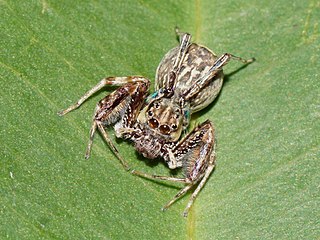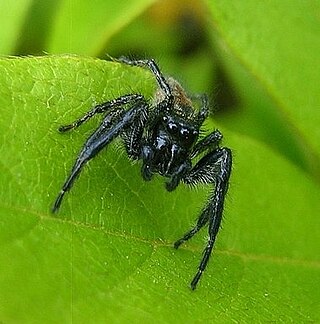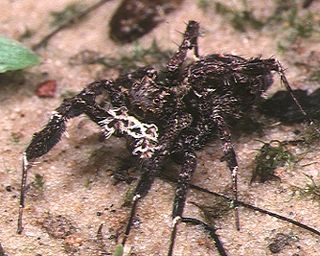
Myrmarachne is a genus of ant-mimicking jumping spiders that was first described by W. S. MacLeay in 1839. They are commonly called antmimicking spiders, but they are not the only spiders that have this attribute. The name is a combination of Ancient Greek μύρμηξ, meaning "ant", and ἀράχνη, meaning "spider".
Bathippus is a genus of jumping spiders.

Brettus is a genus of jumping spiders. Its six described species are found in southern Asia from India to China and Sulawesi, with a single species endemic to Madagascar.

Carrhotus is a genus of jumping spiders that was first described by Tamerlan Thorell in 1891. The name is derived from the Greek Κάῤῥωτος.
Ceglusa is a monotypic genus of Burmese jumping spiders containing the single species, Ceglusa polita. It was first described by Tamerlan Thorell in 1895, and is only found in Myanmar. It was described from a single 5 millimetres (0.20 in) long female, and no drawings exist. and no studies were published on it since. Its taxonomic relationships within the family are unknown.
Colyttus is a genus of Asian jumping spiders that was first described by Tamerlan Thorell in 1891. It is named for the Latin word for "with two stripes". C. lehtinen is named in honor of Finnish arachnologist Pekka T. Lehtinen.

Epeus is a genus of the spider family Salticidae. They are often found on broad-leaved plants or shrubs of rain forest, or in gardens of Southeast Asia.

Hyllus is a genus of the spider family Salticidae. Most species occur in Africa and Madagascar, with many in Australasia and north to India. H. insularis is found in Greece and Iran, but it is considered misplaced in this genus, and is now Evarcha insularis.

Piranthus is a genus of jumping spiders first described in 1895 by Tamerlan Thorell, who derived the name from Greek mythology. As of February 2019 this genus contains only two species.

Thiania is a genus of jumping spiders that was first described by Carl Ludwig Koch in 1846.

Vailimia is a genus of Asian jumping spiders. The type species was described in 1907 from a single male about 6 millimetres (0.24 in) long. It was originally thought to be close to Harmochirus, but the male pedipalp, chelicera, and cephalothorax drawn by Proszynski in 1984, and information gained from later collected specimens indicates otherwise. Subsequently, five more species have been identified. It may be a synonym for Pancorius.

Selenocosmia is a genus of tarantulas that was first described by Anton Ausserer in 1871. The genus is found in China, New Guinea, Indonesia, Australia, Indonesia, Myanmar, Malaysia, Laos, Vietnam, Philippines, India and Pakistan. They are commonly referred to as whistling or barking spiders, due to their ability to stridulate using lyra hairs.

The Spartaeinae are a subfamily of the spider family Salticidae. The subfamily was established by Fred R. Wanless in 1984 to include the groups Boetheae, Cocaleae, Lineae, Codeteae and Cyrbeae, which in turn were defined by Eugène Simon.

Euophryini is a tribe of jumping spiders. It has also been treated as the subfamily Euophryinae.

Dolichognatha is a genus of tropical and subtropical long-jawed orb-weavers that was first described by Octavius Pickard-Cambridge in 1869. Originally placed with the Archaeidae, it was transferred to the Araneidae in 1967, and to the Tetragnathidae in 1981.

Chilobrachys is a genus of Asian tarantulas that was first described by Ferdinand Anton Franz Karsch in 1892. They are found in India, Myanmar, Malaysia, China, Vietnam, Thailand and Sri Lanka. They are usually medium or large-sized, and they can stridulate by using small spines present on the chelicerae.
Parabathippus is a genus of Southeast Asian jumping spiders that was first described by J. X. Zhang & Wayne Paul Maddison in 2012.
Orcevia is a genus of Asian jumping spiders first described by Tamerlan Thorell in 1890. Laufeia, circumscribed to include Orcevia, is placed in the tribe Euophryini in the Salticoida clade of Salticinae. It was once considered a synonym of Laufeia, but it was revalidated in 2019.
Padillothorax is a genus of southeastern Asian jumping spiders first described by Eugène Simon in 1901. As of April 2019 it contains only two species.












